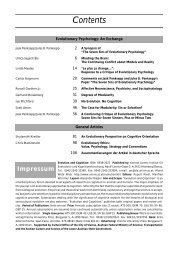Contents - Konrad Lorenz Institute
Contents - Konrad Lorenz Institute
Contents - Konrad Lorenz Institute
You also want an ePaper? Increase the reach of your titles
YUMPU automatically turns print PDFs into web optimized ePapers that Google loves.
Steven M. Platek<br />
An Evolutionary Model of the Effects of Human<br />
Paternal Resemblance on Paternal Investment<br />
A<br />
Abstract<br />
Species with fertilization internal to females face an<br />
asymmetry in parental certainty: whereas females are<br />
always 100% certain that they will share approximately<br />
50% of their genes in common with their offspring,<br />
males can never be certain of paternity. As a<br />
consequence of this uncertainty, investment in offspring<br />
is similarly asymmetrical and should be, according<br />
to evolutionary meta-theory, proportional to<br />
the confidence of paternity on the part of males. There<br />
are three ways in which a male can attempt to limit<br />
cuckoldry. First, he can monitor his mate during the<br />
time that she is fertile and engage in tactics that limit<br />
her opportunities to engage in extra-pair copulations<br />
(EPCs). Second, males have been designed in such a<br />
way that if an EPC does occur and results in extra pair<br />
paternity (EPP), physiological and behavioral processes<br />
out of his conscious control help to limit cuckoldry—namely,<br />
sperm competition and semen<br />
displacement. Finally, post-parturition he can make<br />
assessments about whether the child shares genes in<br />
common with him by estimating the degree to which<br />
his offspring resemble him. Here I model the third process,<br />
the effect that paternal resemblance might have<br />
on a male’s decisions about how or whether to invest<br />
in putative offspring. Additionally, I speculate about<br />
the effects resemblance might have in situations of<br />
known non-paternity (i.e., step-children and adoption),<br />
instances of suspicion about paternity of any<br />
one offspring, and the effects of kin selection and kin<br />
resemblance.<br />
Key words<br />
Paternal investment, paternal resemblance, social<br />
mirror, evolutionary psychology, fluctuating asymme-<br />
fter making a choice<br />
about with whom to<br />
mate, females are faced<br />
with two potential dilemmas:<br />
1) what is the likelihood<br />
that this male is going<br />
to invest resources in<br />
offspring produced, and<br />
2) does the male provide<br />
“good genes,”—that is,<br />
offer genetic resiliency to<br />
pathogens that will facilitate<br />
the offspring’s development<br />
and reproductive<br />
success<br />
Males, on the other<br />
hand, are faced with a different<br />
dilemma: making<br />
sure that the offspring<br />
they invest resources in<br />
shares copies of his genes.<br />
Males have evolved psychological<br />
mechanisms<br />
that help to reduce the<br />
likelihood of unknowingly<br />
raising another<br />
man’s child. The first<br />
mechanism is to attempt<br />
to limit his mate’s opportunities<br />
for extra-pair<br />
copulation (EPC) that<br />
could eventuate in extrapair<br />
paternity (EPP).<br />
Males appear to have<br />
evolved three sets of psychological<br />
mechanisms<br />
designed to reduce, limit,<br />
and control female infidelity. For example, mate<br />
guarding and jealousy during a female’s most fertile<br />
period will help to reduce and possibly prevent a female’s<br />
chances of becoming inseminated by another<br />
male (BUSS 2000). If<br />
mate guarding fails to<br />
prevent an EPC from<br />
eventuating in EPP, males<br />
unknowingly employ a<br />
number of competitive<br />
strategies that help to ensure<br />
that his sperm reach<br />
the egg, and not another<br />
male’s. These strategies<br />
include, but may not be<br />
limited to, sperm competition<br />
(BAKER/BELLIS 1995)<br />
and semen displacement<br />
(GALLUP et al. 2003).<br />
Sperm competition entails<br />
a number of strategies<br />
that enhance placement<br />
and volume of<br />
sperm in the vagina; e.g.,<br />
ejaculating small<br />
amounts of spermicidal<br />
fluids that act to kill an<br />
interloper’s sperm<br />
(BAKER/BELLIS 1995) and<br />
increasing semen volume<br />
as a function of jealousy<br />
and time spent apart<br />
(BAKER/BELLIS 1995;<br />
POUND et al. 2002), which<br />
effectively increases the<br />
statistical probability that<br />
a male will father the<br />
child. Semen displacement<br />
is the result of interplay<br />
between a morphological<br />
adaptation (the<br />
shape of the penis, in particular the glans penis) and<br />
behavioral adaptations that capitalize on that morphological<br />
adaptation; i.e., the morphology of the<br />
human penis allows a male to employ his penis to<br />
Evolution and Cognition ❘ 189 ❘ 2003, Vol. 9, No. 2








